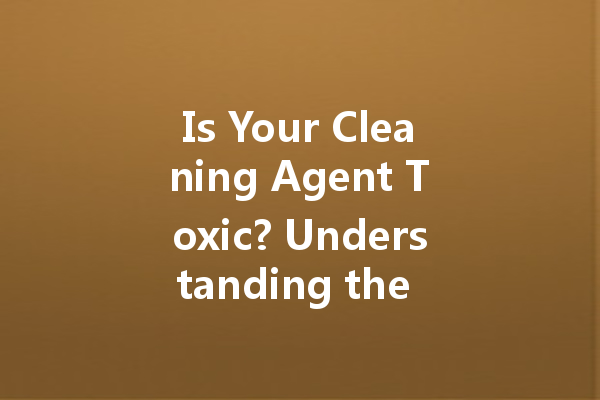Cleaning agents are an essential part of maintaining a clean and healthy environment, whether in our homes, workplaces, or public spaces. However, many people are increasingly concerned about the safety of these products, particularly regarding their chemical compositions and potential toxicity. This article explores common cleaning agents, evaluates their safety, and offers tips for choosing safer alternatives.
O que são agentes de limpeza?
Cleaning agents are substances used to remove dirt, stains, and impurities from surfaces. They can be found in various forms, including liquids, powders, foams, and sprays. The effectiveness of a cleaning agent often depends on its chemical composition, which can range from natural ingredients to synthetic compounds. Examples include detergents, solvents, and disinfectants.
Tipos comuns de agentes de limpeza
When shopping for cleaning products, you will come across various types tailored for specific tasks:
Produtos de limpeza multiusos
All-purpose cleaners are versatile products designed for general cleaning tasks. They can be used on multiple surfaces, such as countertops, floors, and appliances. While they are convenient, it’s essential to check their ingredients, as many contain harsh chemicals that can irritate skin or affect indoor air quality.
Desinfectantes
Disinfectants are specifically formulated to kill germs and bacteria on surfaces. They are commonly used in kitchens and bathrooms. While they are effective in promoting hygiene, some disinfectants can be toxic, especially if ingested or inhaled in large quantities. Always use these products according to the manufacturer’s instructions and ensure good ventilation during use.
Window and Glass Cleaners
Glass cleaners are designed to leave glass surfaces streak-free and shiny. However, many traditional glass cleaners contain ammonia or other harsh chemicals. Opting for eco-friendly alternatives can reduce exposure to potentially harmful substances.
Limpadores de chão
Floor cleaners come in various formulations, depending on the type of flooring. Some can be very effective, while others may leave behind residues that can be harmful to pets and children. It’s crucial to identify the right limpador for your flooring type and consider using non-toxic options.
Os produtos de limpeza de cozinha são tóxicos?
Kitchen cleaners are essential for maintaining a sanitary cooking area, but they can also be a source of concern for many households. Common ingredients in kitchen cleaners include bleach, ammonia, and phosphates—substances that can be harmful when misused. It is vital to read the labels and choose products with safer formulations, such as those that are non-toxic or plant-based.
Understanding Foams and Adhesive Cleaners

Is Foam Cleaner Toxic?
Foam cleaners, which are popular for their thick consistency and ease of use, may contain chemicals like surfactants and solvents. While many foam cleaners are safe when used correctly, others can release harmful fumes. They can also cause skin or eye irritation. Always check for safety data and use them in well-ventilated areas.
The Risks of Adhesive Cleaners
Adhesive cleaners, commonly used for removing stickers or residue, often contain strong solvents. These products can be effective but may pose health risks if inhaled or absorbed through the skin. Exploring non-toxic adhesive remover alternatives can be beneficial for both health and safety.
Tips for Choosing Safe Cleaning Products
Look for Eco-Friendly Labels
When shopping for cleaning agents, prioritize products that are labeled as eco-friendly or non-toxic. These are often free from harmful chemicals and are less likely to emit toxic fumes.
Check Ingredient Lists
Familiarize yourself with common harmful ingredients such as formaldehyde, chlorine bleach, and phosphates. By avoiding products containing these substances, you can significantly reduce your risk of exposure to toxins.
Consider DIY Alternatives
Many effective cleaning solutions can be made at home using natural ingredients such as vinegar, baking soda, and essential oils. DIY cleaners can be just as effective and are often healthier alternatives to commercial products.
Assegurar uma ventilação adequada
Whenever using cleaning agents, ensure that your area is well-ventilated. Open windows and doors to allow fresh air to circulate and reduce the concentration of potentially harmful fumes.
Conclusão
Understanding the safety of cleaning agents is crucial for maintaining a healthy living environment. By being informed about the types of products available, recognizing potential toxins, and opting for safer alternatives, individuals can minimize their risk of exposure to harmful chemicals. Remember to read labels, prioritize eco-friendly options, and consider making your own cleaning solutions to enhance both your home’s cleanliness and your health. With these tips in mind, you can keep your spaces clean and safe without compromising on well-being.
